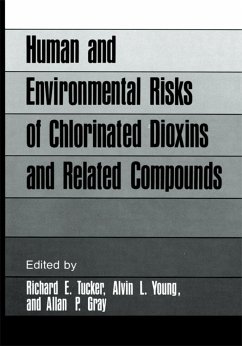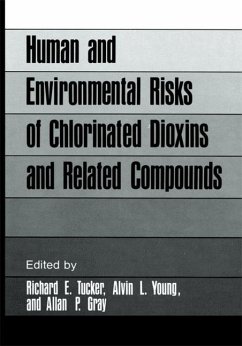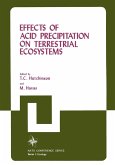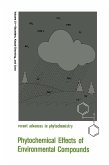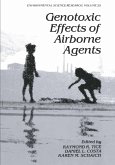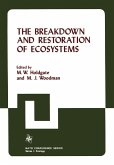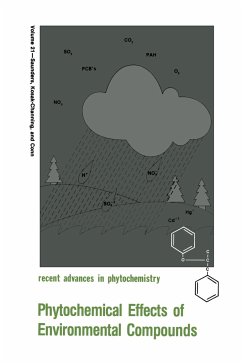Richard E. Tucker
Human and Environmental Risks of Chlorinated Dioxins and Related Compounds
Richard E. Tucker
Human and Environmental Risks of Chlorinated Dioxins and Related Compounds
- Gebundenes Buch
- Merkliste
- Auf die Merkliste
- Bewerten Bewerten
- Teilen
- Produkt teilen
- Produkterinnerung
- Produkterinnerung
Increasing international concern is being expressed regarding the contamination of the environment with polychlorinated dibenzo-p dioxins (PCDDs) and polychlorinated dibenzofurans because certain of these chemicals have been shown to be highly toxic to animals and are ubiquitous in the environment. They are known to be distributed as contaminants of commercial products and as by-products from com bustion processes. A considerable volume of information has accumulated on these chemicals in the past two decades, particularly for the most toxic of them, 2,3,7,8-tetrach1orodibenzo-p-dioxin…mehr
Andere Kunden interessierten sich auch für
![Human and Environmental Risks of Chlorinated Dioxins and Related Compounds Human and Environmental Risks of Chlorinated Dioxins and Related Compounds]() Richard E. TuckerHuman and Environmental Risks of Chlorinated Dioxins and Related Compounds42,99 €
Richard E. TuckerHuman and Environmental Risks of Chlorinated Dioxins and Related Compounds42,99 €![Effects of Acid Precipitation on Terrestrial Ecosystems Effects of Acid Precipitation on Terrestrial Ecosystems]() Thomas C. HutchinsonEffects of Acid Precipitation on Terrestrial Ecosystems112,99 €
Thomas C. HutchinsonEffects of Acid Precipitation on Terrestrial Ecosystems112,99 €![Phytochemical Effects of Environmental Compounds Phytochemical Effects of Environmental Compounds]() James A. SaundersPhytochemical Effects of Environmental Compounds112,99 €
James A. SaundersPhytochemical Effects of Environmental Compounds112,99 €![Effects of Acid Precipitation on Terrestrial Ecosystems Effects of Acid Precipitation on Terrestrial Ecosystems]() Thomas C. HutchinsonEffects of Acid Precipitation on Terrestrial Ecosystems42,99 €
Thomas C. HutchinsonEffects of Acid Precipitation on Terrestrial Ecosystems42,99 €![Genotoxic Effects of Airborne Agents Genotoxic Effects of Airborne Agents]() Raymond R. TiceGenotoxic Effects of Airborne Agents112,99 €
Raymond R. TiceGenotoxic Effects of Airborne Agents112,99 €![The Breakdown and Restoration of Ecosystems The Breakdown and Restoration of Ecosystems]() M.W. Holdgate (ed.) / M.J. WoodmanThe Breakdown and Restoration of Ecosystems113,99 €
M.W. Holdgate (ed.) / M.J. WoodmanThe Breakdown and Restoration of Ecosystems113,99 €![Phytochemical Effects of Environmental Compounds Phytochemical Effects of Environmental Compounds]() James A. SaundersPhytochemical Effects of Environmental Compounds42,99 €
James A. SaundersPhytochemical Effects of Environmental Compounds42,99 €-
-
-
Increasing international concern is being expressed regarding the contamination of the environment with polychlorinated dibenzo-p dioxins (PCDDs) and polychlorinated dibenzofurans because certain of these chemicals have been shown to be highly toxic to animals and are ubiquitous in the environment. They are known to be distributed as contaminants of commercial products and as by-products from com bustion processes. A considerable volume of information has accumulated on these chemicals in the past two decades, particularly for the most toxic of them, 2,3,7,8-tetrach1orodibenzo-p-dioxin (2,3,7,8-TCDD). However, this body of knowledge has not succeeded in resolving genuine judgmental differences among experts in the field as to the degree of hazard to human health and the environment. In light of the widespread public concern, it is clearly imperative to come to grips with the continuing scientific controversy, to review the data, assess the issues, to see where areas of agreement exist, and where further research is needed to resolve remaining areas of disagree ment. This volume represents an effort to contribute to these goals.
Hinweis: Dieser Artikel kann nur an eine deutsche Lieferadresse ausgeliefert werden.
Hinweis: Dieser Artikel kann nur an eine deutsche Lieferadresse ausgeliefert werden.
Produktdetails
- Produktdetails
- Environmental Science Research 26
- Verlag: Springer, Berlin
- 1983.
- Seitenzahl: 823
- Erscheinungstermin: 1. März 1983
- Englisch
- Gewicht: 1570g
- ISBN-13: 9780306411700
- ISBN-10: 0306411709
- Artikelnr.: 24470038
- Herstellerkennzeichnung
- Libri GmbH
- Europaallee 1
- 36244 Bad Hersfeld
- gpsr@libri.de
- Environmental Science Research 26
- Verlag: Springer, Berlin
- 1983.
- Seitenzahl: 823
- Erscheinungstermin: 1. März 1983
- Englisch
- Gewicht: 1570g
- ISBN-13: 9780306411700
- ISBN-10: 0306411709
- Artikelnr.: 24470038
- Herstellerkennzeichnung
- Libri GmbH
- Europaallee 1
- 36244 Bad Hersfeld
- gpsr@libri.de
Definition of the Problem.- Dioxins as Contaminants of Herbicides: The U. S. Perspective.- Dioxins as Contaminants of Herbicides: Australian Perspective.- The Use of Scientific Information in the Development of Public Policies.- Regulatory Actions on Dioxins and Related Compounds.- Dioxins and Related Compounds as International Issues of Concern.- Analytical Chemistry.- Analytical Methodology for the Determination of PCDDs and PCDFs in Products and Environmental Samples: An Overview and Critique.- High Resolution Mass Spectrometry Methods of Analysis for Chlorinated dibenzo-p-dioxins and dibenzofurans.- Determination of tetrachlorodibenzo-p-dioxins and tetra-chlorodibenzofurans in Environmental Samples by High Performance Liquid Chromatography, capillary gas chromatography and High Resolution Mass Spectrometry.- Methodology and Preliminary Results for the Isomer-Specific Determination of TCDDs and Higher Chlorinated Dibenzo-p-dioxins in Chimney Particulates from Wood-Fueled Domestic Furnaces Located in Eastern, Central, and Western Regions of the United States.- Sampling and Analytical Methodologies for PCDDs and PCDFs in Incinerators and Wood Burning Facilities.- Comparative Monitoring and Analytical Methodology for 2,3,7,8-TCDD in Fish.- Environmental Chemistry.- Emissions of PCDDs and PCDFs from Combustion Sources.- Changes in Dioxin Isomer Group Ratios in the Environment: An Update and Extension of the Present Theory.- Analyses for 2,3,7,8-Tetrachlorodbenzo-p-dioxin Residues in Environmental Samples.- Long-Term Studies on the Persistence and Movement of TCDD in a Natural Ecosystem.- Microbial Degradation of TCDD in a Model Ecosystem.- Residues of Polychlorinated Dibenzo-p-dioxins and Dibenzo-furans in the Laurentian Great Lakes Fish.- Identification of Polychlorinated Dioxins (PCDDs) and Dibenzofurans (PCDFs) in Human Samples, Occupational Exposure and Yusho Patients.- Seveso - An Environmental Assessment.- Environmental Toxicology.- Environmental Toxicity of TCDD.- The Theory of Accumulation and Its Relationship to the Choice of Monitoring Matrices for Dioxins.- A Field Study of Soil and Biological Specimens from a Herbicide Storage and Aerial-Test Staging Site Following Long-Term Contamination with TCDD.- Chick Edema Disease and Hepatic Porphyria in Lake Ontario Herring Gull Embryos in the Early 1970s.- Long-Term Field Studies of a Rodent Population Continuously Exposed to TCDD.- Ultrastructural Comparison of Liver Tissues from Field and Laboratory TCDD-Exposed Beach Mice.- Biochemistry and Metabolism.- PCDDs and Related Compounds: Metabolism and Biochemistry.- 2,3,7,8-Tetrachlorodibenzo-p-Dioxin-Induced Weight Loss: A Proposed Mechanism.- Studies of the Mechanism of Action of Hepatotoxicity of 2,3,7,8-Tetrachlorodibenzo-p-dioxin (TCDD) and Related Compounds.- The Ah Receptor: A Specific Site for Action of Chlorinated Dioxins?.- Genetic Differences in Enzymes Which Metabolize Drugs, Chemical Carcinogens, and Other Environmental Pollutants.- Factors Affecting the Disposition and Persistence of Halogenated Furans and Dioxins.- Adipose Tissue Storage of Polychlorinated Compounds.- Structure Elucidation of Mammalian TCDD-Metabolites.- Animal Toxicology.- Absorption, Distribution and Metabolism of 2,3,7,8-Tetra-chlorodibenzodioxin (TCDD) in Experimental Animals.- Morphology of Lesions Produced by the Dioxins and Related Compounds.- A Consideration of the Mechanism of Action of 2,3,7,8-Tetra-chlorodibenzo-p-dioxin and Related Halogenated Aromatic Hydrocarbons.- Human Observations.- Methodology of Clinical Studies on ExposedPopulations.- A Mortality Study of Workers Employed at the Monsanto Company Plant in Nitro, West Virginia.- Dioxin and Reproductive Events.- Significance of Cutaneous Lesions in the Symptomatology of Exposure to Dioxins and Other Chloracnegens.- Soft Tissue Sarcomas: Clues and Caution.- Risk Assessment.- Risk Assessment: Introductory Remarks.- Assessing Risk in Legal Proceedings: How to Deal With Scientific Uncertainty in Toxic Substances Risk Assessments.- Some General Observations on the Safety of PCDDs.- Risk Assessment for Regulation of Dioxin (TCDD).- Risk Assessment for 2,3,7,8-Tetrachlorodibenzo-p-dioxin (TCDD).- Laboratory Safety and Waste Management.- An Overview of Laboratory and Waste Management Guidelines for Toxic Chlorinated Dibenzo-p-dioxins and Dibenzofurans.- Laboratory Design Considerations for the Handling and Analysis of Chlorinated Dioxins and Related Compounds.- Safe Handling of Toxic Chemicals: Perspectives of a Bench Chemist and Laboratory Manager.- Safety Precautions for the Handling of TCDD.- A Program for Monitoring Potential Contamination in the Laboratory Following the Handling and Analyses of Chlorinated Dibenzo-p-dioxins and Dibenzofurans.- A Medical Surveillance Program for Scientists Exposed to Dioxins and Furans.- Laboratory Handling and Disposal of Chlorinated Dioxin Wastes.- Physical and Chemical Properties of Dioxins in Relation to their Disposal.- The Design, Implementation and Evaluation of the Industrial Hygiene Program Used During the Disposal of Herbicide Orange.- Panel Reports.- Analytical Chemistry.- Environmental Chemistry.- Environmental Toxicology.- Biochemistry and Metabolism.- Animal Toxicology.- Human Observations.- Laboratory Safety and Waste Management.- Author Index.
Definition of the Problem.- Dioxins as Contaminants of Herbicides: The U. S. Perspective.- Dioxins as Contaminants of Herbicides: Australian Perspective.- The Use of Scientific Information in the Development of Public Policies.- Regulatory Actions on Dioxins and Related Compounds.- Dioxins and Related Compounds as International Issues of Concern.- Analytical Chemistry.- Analytical Methodology for the Determination of PCDDs and PCDFs in Products and Environmental Samples: An Overview and Critique.- High Resolution Mass Spectrometry Methods of Analysis for Chlorinated dibenzo-p-dioxins and dibenzofurans.- Determination of tetrachlorodibenzo-p-dioxins and tetra-chlorodibenzofurans in Environmental Samples by High Performance Liquid Chromatography, capillary gas chromatography and High Resolution Mass Spectrometry.- Methodology and Preliminary Results for the Isomer-Specific Determination of TCDDs and Higher Chlorinated Dibenzo-p-dioxins in Chimney Particulates from Wood-Fueled Domestic Furnaces Located in Eastern, Central, and Western Regions of the United States.- Sampling and Analytical Methodologies for PCDDs and PCDFs in Incinerators and Wood Burning Facilities.- Comparative Monitoring and Analytical Methodology for 2,3,7,8-TCDD in Fish.- Environmental Chemistry.- Emissions of PCDDs and PCDFs from Combustion Sources.- Changes in Dioxin Isomer Group Ratios in the Environment: An Update and Extension of the Present Theory.- Analyses for 2,3,7,8-Tetrachlorodbenzo-p-dioxin Residues in Environmental Samples.- Long-Term Studies on the Persistence and Movement of TCDD in a Natural Ecosystem.- Microbial Degradation of TCDD in a Model Ecosystem.- Residues of Polychlorinated Dibenzo-p-dioxins and Dibenzo-furans in the Laurentian Great Lakes Fish.- Identification of Polychlorinated Dioxins (PCDDs) and Dibenzofurans (PCDFs) in Human Samples, Occupational Exposure and Yusho Patients.- Seveso - An Environmental Assessment.- Environmental Toxicology.- Environmental Toxicity of TCDD.- The Theory of Accumulation and Its Relationship to the Choice of Monitoring Matrices for Dioxins.- A Field Study of Soil and Biological Specimens from a Herbicide Storage and Aerial-Test Staging Site Following Long-Term Contamination with TCDD.- Chick Edema Disease and Hepatic Porphyria in Lake Ontario Herring Gull Embryos in the Early 1970s.- Long-Term Field Studies of a Rodent Population Continuously Exposed to TCDD.- Ultrastructural Comparison of Liver Tissues from Field and Laboratory TCDD-Exposed Beach Mice.- Biochemistry and Metabolism.- PCDDs and Related Compounds: Metabolism and Biochemistry.- 2,3,7,8-Tetrachlorodibenzo-p-Dioxin-Induced Weight Loss: A Proposed Mechanism.- Studies of the Mechanism of Action of Hepatotoxicity of 2,3,7,8-Tetrachlorodibenzo-p-dioxin (TCDD) and Related Compounds.- The Ah Receptor: A Specific Site for Action of Chlorinated Dioxins?.- Genetic Differences in Enzymes Which Metabolize Drugs, Chemical Carcinogens, and Other Environmental Pollutants.- Factors Affecting the Disposition and Persistence of Halogenated Furans and Dioxins.- Adipose Tissue Storage of Polychlorinated Compounds.- Structure Elucidation of Mammalian TCDD-Metabolites.- Animal Toxicology.- Absorption, Distribution and Metabolism of 2,3,7,8-Tetra-chlorodibenzodioxin (TCDD) in Experimental Animals.- Morphology of Lesions Produced by the Dioxins and Related Compounds.- A Consideration of the Mechanism of Action of 2,3,7,8-Tetra-chlorodibenzo-p-dioxin and Related Halogenated Aromatic Hydrocarbons.- Human Observations.- Methodology of Clinical Studies on ExposedPopulations.- A Mortality Study of Workers Employed at the Monsanto Company Plant in Nitro, West Virginia.- Dioxin and Reproductive Events.- Significance of Cutaneous Lesions in the Symptomatology of Exposure to Dioxins and Other Chloracnegens.- Soft Tissue Sarcomas: Clues and Caution.- Risk Assessment.- Risk Assessment: Introductory Remarks.- Assessing Risk in Legal Proceedings: How to Deal With Scientific Uncertainty in Toxic Substances Risk Assessments.- Some General Observations on the Safety of PCDDs.- Risk Assessment for Regulation of Dioxin (TCDD).- Risk Assessment for 2,3,7,8-Tetrachlorodibenzo-p-dioxin (TCDD).- Laboratory Safety and Waste Management.- An Overview of Laboratory and Waste Management Guidelines for Toxic Chlorinated Dibenzo-p-dioxins and Dibenzofurans.- Laboratory Design Considerations for the Handling and Analysis of Chlorinated Dioxins and Related Compounds.- Safe Handling of Toxic Chemicals: Perspectives of a Bench Chemist and Laboratory Manager.- Safety Precautions for the Handling of TCDD.- A Program for Monitoring Potential Contamination in the Laboratory Following the Handling and Analyses of Chlorinated Dibenzo-p-dioxins and Dibenzofurans.- A Medical Surveillance Program for Scientists Exposed to Dioxins and Furans.- Laboratory Handling and Disposal of Chlorinated Dioxin Wastes.- Physical and Chemical Properties of Dioxins in Relation to their Disposal.- The Design, Implementation and Evaluation of the Industrial Hygiene Program Used During the Disposal of Herbicide Orange.- Panel Reports.- Analytical Chemistry.- Environmental Chemistry.- Environmental Toxicology.- Biochemistry and Metabolism.- Animal Toxicology.- Human Observations.- Laboratory Safety and Waste Management.- Author Index.

